| This page focuses on the Orca (Killer Whale) and the more rarely seen toothed whales in Monterey Bay. All the Orca photos are a from Monterey Bay but those of very rare species are from warmer waters (except for beached specimens). Other rarely seen toothed cetaceans are the Sperm Whale and various beaked whales of the genera Mesoplodon or Ziphius or Berardius; see my separate page on Monterey Bay sperm whale & beaked whales. | |
 |
|
 |
|
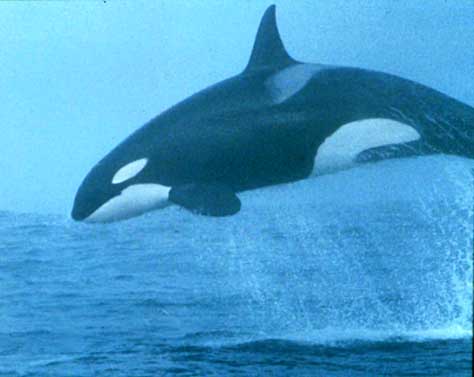
The Orca (often called "Killer Whale") Orcinus orca is the top mammalian predator in Monterey Bay. Moving in well-organized packs recalling those of wolves, some pods of Orcas feed on migrating large baleen whales while others pursue fish, sea-lions, or even the occasional seabird. The striking males (uppermost photo) have huge towering dorsal fines while those of fast-moving females (next to top photo) are much smaller. Only rarely do they engage in full-body leaps out of the ocean as caught in this dramatic shot by Leo Hallford on Monterey Bay (right; © 2001 Leo Hallford, used with permission; all rights reserved). |
|
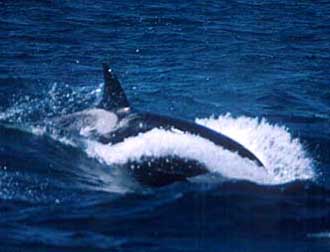 Much
research has been undertaken on the Orcas of Monterey Bay and vicinity.
An Orca photo catalog has been compiled (Black et al. 1996) and over 180
individual whales have been identified. Some of the Monterey Bay killer
whales have been photo-identified as far north as Alaska and as far south
as Mexico. These "transient" whales seem to follow the migrating gray whales
or other large baleen whales, just as wolves follow the caribou on the
arctic tundra or lions follow the wildebeest herds in east Africa. Other
Orcas appear to be more "resident." Intense research on Orcas in the Pacific
Northwest have documented separate populations of "transient" and "resident"
whales and while there are some structural differences, most of the characters
that separate these two "types" are behavioral (Heyning & Dahlheim
1993). Genetic studies have shown that the resident and transient pods
differ genetically, but the genetic differentiation is consistent with
a matriarchal population structure and a small population size, rather
than genetic divergence at a taxonomic level (Hoelzel & Dover 1991,
Hoelzel et al. 1998). Much
research has been undertaken on the Orcas of Monterey Bay and vicinity.
An Orca photo catalog has been compiled (Black et al. 1996) and over 180
individual whales have been identified. Some of the Monterey Bay killer
whales have been photo-identified as far north as Alaska and as far south
as Mexico. These "transient" whales seem to follow the migrating gray whales
or other large baleen whales, just as wolves follow the caribou on the
arctic tundra or lions follow the wildebeest herds in east Africa. Other
Orcas appear to be more "resident." Intense research on Orcas in the Pacific
Northwest have documented separate populations of "transient" and "resident"
whales and while there are some structural differences, most of the characters
that separate these two "types" are behavioral (Heyning & Dahlheim
1993). Genetic studies have shown that the resident and transient pods
differ genetically, but the genetic differentiation is consistent with
a matriarchal population structure and a small population size, rather
than genetic divergence at a taxonomic level (Hoelzel & Dover 1991,
Hoelzel et al. 1998).
Orcas are the most widely distributed marine mammal in the world. They occur in all the oceans of the world. Here in Monterey Bay they are found with regularity but it is difficult to predict just when and where. It is certainly a major treat to be on a boat trip that comes upon a pod of these spectacular whales. A local visitor can learn more about Orcas (and other Monterey Bay cetaceans) in the rather new "cetacean room" at the Pacific Grove Museum of Natural History, Forest & Central in Pacific Grove (open daily except Mondays; free admission) and at the Monterey Bay Aquarium. These Monterey Bay killer whale photos were taken 22 Sep 1982 (top shot of two males), 4 Sep 2000 (both shots of fast-moving female), and Oct 1979 (Leo Hallford's leaping Orca).
|
|
|
|
|
 |
|
 While
Orcas can be found regularly on Monterey Bay, the Short-finned Pilot
Whale Globicephala macrorhychus is strictly a rarity here. Indeed,
I have never seen a live pilot whale in over 30 years of trips on Monterey
Bay, and don't know anyone who has, although the literature cites a smattering
of records north to the Gulf of Alaska (Leatherwood et al. 1982). My photos
of a Short-finned Pilot Whale (above & right) were taken off
southern California at 34°27'N, 121°59'W, 75 miles from Pt. Arguello,
Santa Barbara County. This is the farthest north I've ever seen a pilot
whale (it was on 6 Feb 1993 during unusually warm waters). Note the very
broad base to the rounded dorsal fin, a key field identification point
(above) and the large bulbous head (right) in the close-up view. The very
few records of pilot whales from the Monterey Bay region are almost all
beach-cast dead whales like this adult female found on Del Monte Beach,
Monterey, 8 Nov 2000 (photos below © 2001 Meisha Key, used with permission;
all right reserved). She was just freshly dead but within a few hours the
white markings on her breast and the pale saddle on her back were fading
away. She was about 14.5 feet long. Note the nice sharp teeth used for
eating squid. She was removed to Moss Landing Marine Lab for dissection.
The Short-finned Pilot Whale is the only pilot whale in the eastern North
Pacific; the Long-finned Pilot Whale
G. melaena lives in the Atlantic
and in southern hemispheric oceans. While
Orcas can be found regularly on Monterey Bay, the Short-finned Pilot
Whale Globicephala macrorhychus is strictly a rarity here. Indeed,
I have never seen a live pilot whale in over 30 years of trips on Monterey
Bay, and don't know anyone who has, although the literature cites a smattering
of records north to the Gulf of Alaska (Leatherwood et al. 1982). My photos
of a Short-finned Pilot Whale (above & right) were taken off
southern California at 34°27'N, 121°59'W, 75 miles from Pt. Arguello,
Santa Barbara County. This is the farthest north I've ever seen a pilot
whale (it was on 6 Feb 1993 during unusually warm waters). Note the very
broad base to the rounded dorsal fin, a key field identification point
(above) and the large bulbous head (right) in the close-up view. The very
few records of pilot whales from the Monterey Bay region are almost all
beach-cast dead whales like this adult female found on Del Monte Beach,
Monterey, 8 Nov 2000 (photos below © 2001 Meisha Key, used with permission;
all right reserved). She was just freshly dead but within a few hours the
white markings on her breast and the pale saddle on her back were fading
away. She was about 14.5 feet long. Note the nice sharp teeth used for
eating squid. She was removed to Moss Landing Marine Lab for dissection.
The Short-finned Pilot Whale is the only pilot whale in the eastern North
Pacific; the Long-finned Pilot Whale
G. melaena lives in the Atlantic
and in southern hemispheric oceans. |
|
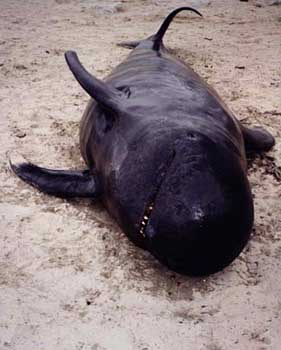 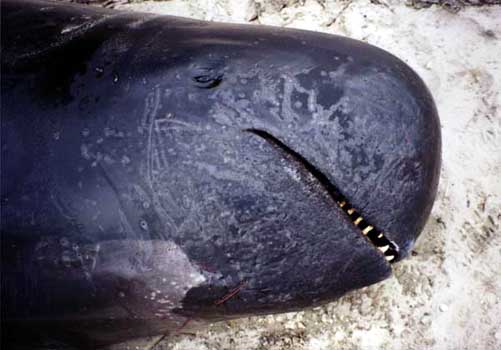 |
|
|
|
|
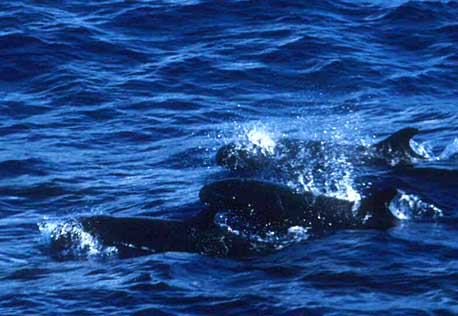 Pilot
whales are fairly commonly encountered in the warmer waters of the eastern
tropical Pacific where they are among a group of smaller toothed wales
collectively termed "blackfish." Another "blackfish" that occurs in these
tropical waters, hunting in small fast-moving packs, is the False Killer
Whale Pseudorca crassidens (right). Although widely distributed
in warmer waters around the world (this photo was taken 22 Aug 1989 at
12°43'N, 143°07'W in the eastern tropical Pacific), the False Killer
Whale is extremely rare north to Monterey Bay. There were a series of sightings,
though, in the exceptional warm waters following the 1982-83 El Niño.
At 7 pm on 30 Aug 1983, Alan Baldridge called to inform me there was a
pod of 40 Pseudorca visible from shore at Pt. Pinos. I was actually
having a dinner party at the time but dragged my guests to the Point (just
4 blocks away) and took these notes: "Pod of smallish (10-15') whales cruising
in bay, seen well with scopes. Very black creatures with no obvious markings.
Mostly just showed dorsal fin and back and then quickly submerge with an
arched lower back reminiscent (though not as pronounced) of Dall's Porpoise.
But some were breaching & jumping -- I did have one very good view
of one leaping showing the pointed, long-looking head and pectoral fins
bent at elbow coming to a point (see sketch [in my notebook]). Watched
for 20 minutes." There are various other rare records north to Washington
State during warm-waters years. Pilot
whales are fairly commonly encountered in the warmer waters of the eastern
tropical Pacific where they are among a group of smaller toothed wales
collectively termed "blackfish." Another "blackfish" that occurs in these
tropical waters, hunting in small fast-moving packs, is the False Killer
Whale Pseudorca crassidens (right). Although widely distributed
in warmer waters around the world (this photo was taken 22 Aug 1989 at
12°43'N, 143°07'W in the eastern tropical Pacific), the False Killer
Whale is extremely rare north to Monterey Bay. There were a series of sightings,
though, in the exceptional warm waters following the 1982-83 El Niño.
At 7 pm on 30 Aug 1983, Alan Baldridge called to inform me there was a
pod of 40 Pseudorca visible from shore at Pt. Pinos. I was actually
having a dinner party at the time but dragged my guests to the Point (just
4 blocks away) and took these notes: "Pod of smallish (10-15') whales cruising
in bay, seen well with scopes. Very black creatures with no obvious markings.
Mostly just showed dorsal fin and back and then quickly submerge with an
arched lower back reminiscent (though not as pronounced) of Dall's Porpoise.
But some were breaching & jumping -- I did have one very good view
of one leaping showing the pointed, long-looking head and pectoral fins
bent at elbow coming to a point (see sketch [in my notebook]). Watched
for 20 minutes." There are various other rare records north to Washington
State during warm-waters years.
That was my only Monterey Bay encounter with False Killer Whales (and many thanks to Alan & Sheila Baldridge for promptly alerting interested folks in these, and of various strandings of rarities over the years). During four months at sea in the eastern tropical Pacific on a research cruise in 1989, I had several more encounters (as shown in the photo). The name "False Killer Whale" comes from a very superficial resemblance to the Orca (Killer Whale) but these lean, fast whales are not really very similar at all. They are all black (except for a pale blaze on the belly, rarely seen) and have pointed pectoral fins unlike the broad rounded paddles of Orca. They are more similar to pilot whales (and about the same size) but the dorsal fin is more recurved and not so broad at base, and they have a thin not bulbous head. Small groups move as if synchronized, and they are often attracted to boats, riding the bow in shallow leaps. Groups hunt small tuna (bonito, mahi-mahi) as a unit, but they also take squid. Every time I've seen them they've been in groups of 20-80. |
|
|
|
|
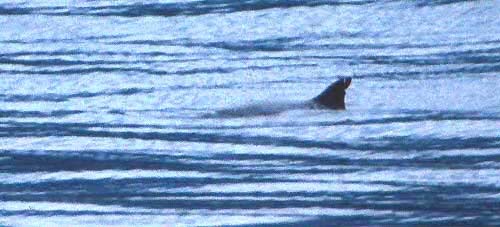 |
|
| Two other small (only 6-9' long) tropical whales in the genus Kogia
have or could occur in Monterey County, especially in exceptional warm
water years. These are the Pygmy Sperm Whale K. breviceps
and Dwarf Sperm Whale K. simus (above). These are little
known deep-water whales that apparently feed on squid and deepwater fishes
and crustaceans. I saw both in the eastern tropical Pacific near the equator
but only on flat calm days; I took this photo (above) off the island of
Dominica in the eastern Caribbean in March 2000. It is essentially impossible
to spot a Kogia on the surface when there is any chop at all. I
don't know anyone whose seen one in California but they are out there.
Leatherwood et al. (1982) includes a photo of a beached Pygmy Sperm Whale
from Monterey County, and cites adjacent San Luis Obispo County for the
northernmost record of Dwarf Sperm Whale.
There is also one Monterey County record of a beached Rough-toothed Dolphin Steno bredanensis; just an old skull (Leatherwood et al. 1982). It is another tropical cetacean and is feature on my Eastern Tropical Pacific cetaceans page. Literature cited: Black, N. A., A. Schulman-Janiger, R. L. Ternullo, and M. Guerrero-Ruiz. 1996. A killer whale catalog for California and western Mexico. Report for Nat'l Marine Fisheries Serv., Southwest Fisheries Science Center/NOAA, contract 40JGNF500356. |